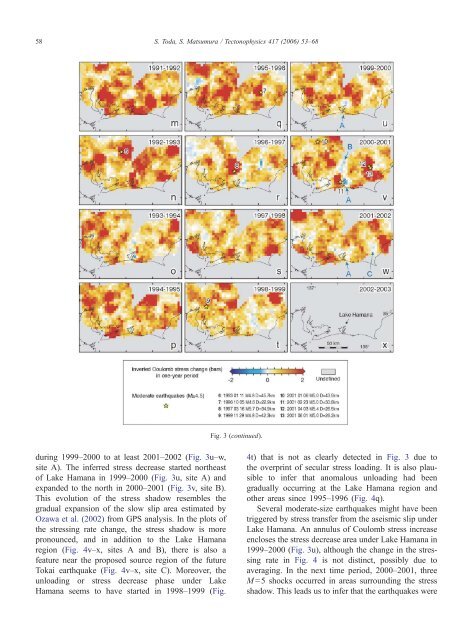Printable article - Evidence from the AD 2000 Izu Islands swarm that ...
Printable article - Evidence from the AD 2000 Izu Islands swarm that ...
Printable article - Evidence from the AD 2000 Izu Islands swarm that ...
- No tags were found...
Create successful ePaper yourself
Turn your PDF publications into a flip-book with our unique Google optimized e-Paper software.
58S. Toda, S. Matsumura / Tectonophysics 417 (2006) 53–68Fig. 3 (continued).during 1999–<strong>2000</strong> to at least 2001–2002 (Fig. 3u–w,site A). The inferred stress decrease started nor<strong>the</strong>astof Lake Hamana in 1999–<strong>2000</strong> (Fig. 3u, site A) andexpanded to <strong>the</strong> north in <strong>2000</strong>–2001 (Fig. 3v, site B).This evolution of <strong>the</strong> stress shadow resembles <strong>the</strong>gradual expansion of <strong>the</strong> slow slip area estimated byOzawa et al. (2002) <strong>from</strong> GPS analysis. In <strong>the</strong> plots of<strong>the</strong> stressing rate change, <strong>the</strong> stress shadow is morepronounced, and in addition to <strong>the</strong> Lake Hamanaregion (Fig. 4v–x, sites A and B), <strong>the</strong>re is also afeature near <strong>the</strong> proposed source region of <strong>the</strong> futureTokai earthquake (Fig. 4v–x, site C). Moreover, <strong>the</strong>unloading or stress decrease phase under LakeHamana seems to have started in 1998–1999 (Fig.4t) <strong>that</strong> is not as clearly detected in Fig. 3 due to<strong>the</strong> overprint of secular stress loading. It is also plausibleto infer <strong>that</strong> anomalous unloading had beengradually occurring at <strong>the</strong> Lake Hamana region ando<strong>the</strong>r areas since 1995–1996 (Fig. 4q).Several moderate-size earthquakes might have beentriggered by stress transfer <strong>from</strong> <strong>the</strong> aseismic slip underLake Hamana. An annulus of Coulomb stress increaseencloses <strong>the</strong> stress decrease area under Lake Hamana in1999–<strong>2000</strong> (Fig. 3u), although <strong>the</strong> change in <strong>the</strong> stressingrate in Fig. 4 is not distinct, possibly due toaveraging. In <strong>the</strong> next time period, <strong>2000</strong>–2001, threeM =5 shocks occurred in areas surrounding <strong>the</strong> stressshadow. This leads us to infer <strong>that</strong> <strong>the</strong> earthquakes were






